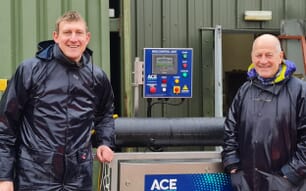Algae are organisms so environmentally adaptable that they flourish in wastelands, sewage and saline bodies of water. They can grow in high densities, in the dark and in the presence of high concentrations of nitrogen and phosphates.
Harnessing the adaptive power of algae is a relatively new research field. Engineers across the country have developed algal biofuels, food additives and skincare products. Livestock scientists see its potential as a sustainable, high-energy feedstuff as well as a protein supplement.
Amongst those scientists are Dr Megan Van Emon, Assistant Professor at Montana State University, Dr Daniel Loy, Professor of Animal Science at Iowa State University and Dr Stephanie Hansen, Assistant Professor at Iowa State University.
Their paper, "Determining the preference, in vitro digestibility, in situ disappearance, and grower period performance of steers fed a novel algae meal derived from heterotrophic microalgae," is featured in June's issue of the Journal of Animal Science.
Solazyme is a company that transforms algae into products like biofuel, cosmetics and cooking oil.
They modify heterotrophic algae, which normally produce 5-10 per cent oil, to produce 80 per cent oil. The organisms are grown and processed in controlled media under very specific conditions. The oil is then harvested and incorporated into a variety of tailored products.
The organization approached Dr Stephanie Hansen and her colleagues to assess the value of the remaining algal fraction, the dry cell wall that would otherwise be burned as waste.
"We looked at the nutrient analysis of a blend of deoiled algae and soyhulls," said Dr Hansen.
"Everyone thought that this could be a great ruminant feedstuff."
While previous studies have studied pure algae supplements as sources of protein or docosahexaenoic acid (DHA), the current study is the first to feed a unique algae meal blend (ALG).
The feedstuff (57 per cent microalgae) has slightly more fat content than corn, the same amount of protein and does not contain DHA.
A preliminary experiment tested the DM digestibility of ALG compared with hay and soyhulls. Three more experiments took place (1) to determine if cattle would readily consume algae meal, (2) to determine the influence of DM disappearance of ALG and other feedstuffs and (3) to determine growth and DMI of ALG-fed grower calves.
Four diets were fed to feedlot steers: a cracked corn control diet, and diets containing 15 per cent , 30 per cent and 45 per cent algae meal (CON, ALG15, ALG30 and ALG45, respectively.)
The first two experiments involved three ruminally cannulated steers, and the third experiment involved 48 grower steers. In the grower study algae meal replaced wet corn gluten feed in the diet.
The trials yielded a myriad of new information, notably:
- Cattle readily consumed algae meal at all concentrations without sorting. (1)
- ADG increased as ALG increased in the diet. (3)
- DMI increased linearly as ALG concentrations increased in the diet. (3)
- Finally, midpoint and final BW of steers were not affected by ALG. (3)
Dr Hansen says this initial collection of data translates to a promising future for algae meal.
"We are currently working on FDA approval for the product," Dr Hansen said. "Hopefully by 2016, cattlemen will be able to start incorporating it into rations, especially if they can find it at the right price."
The research team is working together with Solazyme to determine the financial value of algae meal. Dr Hansen expects the high-energy feedstuff to be priced competitively with corn.
While most research initiatives are still in the experimental stages, continued studies on microalgae means commercial production of algal products is in the near future.
DrHansen and her colleagues recently completed two sheep digestibility projects where algae meal directly replaced soyhulls and corn. Those projects will be presented at the ADSA-ASAS Joint Annual Meeting next month with M.S. candidate Rebecca Stokes as the lead author.
"The sustainability of algae production is pretty promising," Dr Hansen said. "As we move into the next generation of cattle feeding and feedstuffs, it will be interesting to see where present and future versions of algae meal place themselves in the market."




